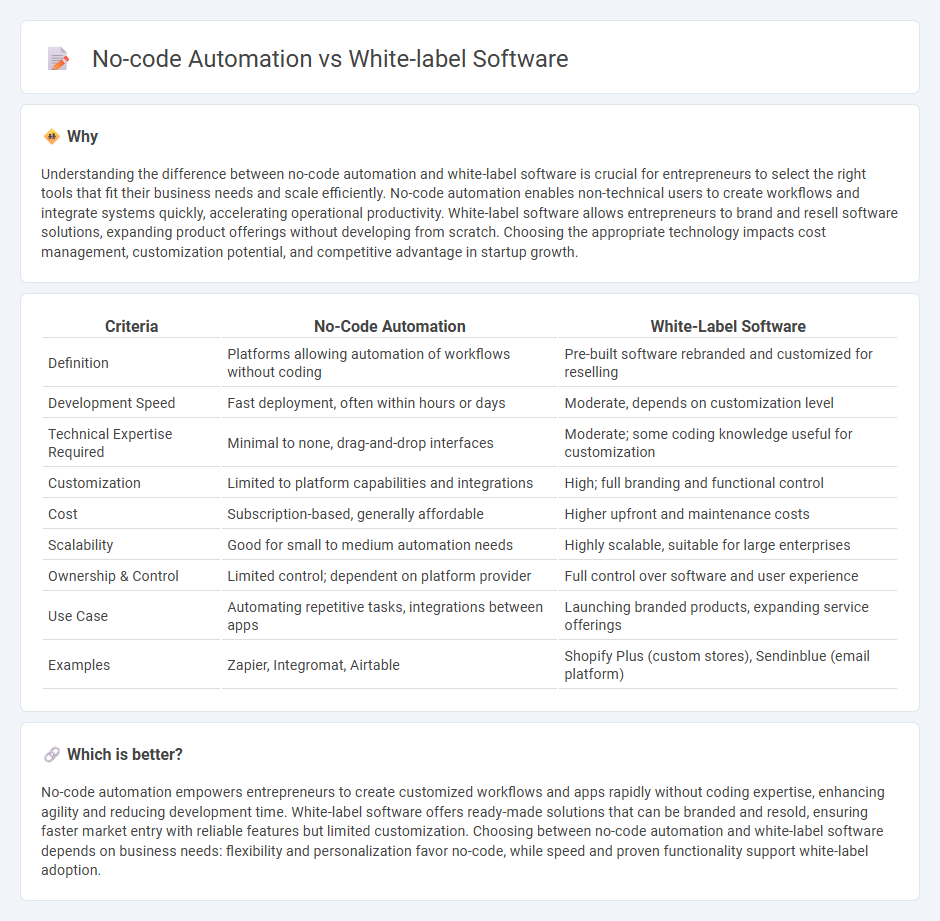
No-code automation empowers entrepreneurs to build and scale business processes without coding expertise, accelerating time-to-market and reducing development costs. White-label software allows startups to rebrand and customize existing applications, providing a ready-made solution that enhances brand identity and customer loyalty. Explore how these innovative tools can transform your entrepreneurial journey and maximize operational efficiency.
Why it is important
Understanding the difference between no-code automation and white-label software is crucial for entrepreneurs to select the right tools that fit their business needs and scale efficiently. No-code automation enables non-technical users to create workflows and integrate systems quickly, accelerating operational productivity. White-label software allows entrepreneurs to brand and resell software solutions, expanding product offerings without developing from scratch. Choosing the appropriate technology impacts cost management, customization potential, and competitive advantage in startup growth.
Comparison Table
| Criteria | No-Code Automation | White-Label Software |
|---|---|---|
| Definition | Platforms allowing automation of workflows without coding | Pre-built software rebranded and customized for reselling |
| Development Speed | Fast deployment, often within hours or days | Moderate, depends on customization level |
| Technical Expertise Required | Minimal to none, drag-and-drop interfaces | Moderate; some coding knowledge useful for customization |
| Customization | Limited to platform capabilities and integrations | High; full branding and functional control |
| Cost | Subscription-based, generally affordable | Higher upfront and maintenance costs |
| Scalability | Good for small to medium automation needs | Highly scalable, suitable for large enterprises |
| Ownership & Control | Limited control; dependent on platform provider | Full control over software and user experience |
| Use Case | Automating repetitive tasks, integrations between apps | Launching branded products, expanding service offerings |
| Examples | Zapier, Integromat, Airtable | Shopify Plus (custom stores), Sendinblue (email platform) |
Which is better?
No-code automation empowers entrepreneurs to create customized workflows and apps rapidly without coding expertise, enhancing agility and reducing development time. White-label software offers ready-made solutions that can be branded and resold, ensuring faster market entry with reliable features but limited customization. Choosing between no-code automation and white-label software depends on business needs: flexibility and personalization favor no-code, while speed and proven functionality support white-label adoption.
Connection
No-code automation platforms empower entrepreneurs to swiftly create and deploy business processes without deep coding expertise, accelerating time-to-market. White-label software complements this by providing customizable, ready-made solutions that entrepreneurs can brand as their own, reducing development costs. Together, they enable scalable, efficient business operations and foster innovation in startup ecosystems.
Key Terms
Customization
White-label software offers extensive customization options by allowing companies to rebrand and tailor features to specific business needs, ensuring a unique user experience. No-code automation provides flexible workflow creation but often has limitations in deep customization due to its standardized, user-friendly interfaces. Explore the advantages and constraints of both to determine the best approach for your business automation strategy.
Integration
White-label software offers seamless integration capabilities by allowing businesses to brand and customize pre-built solutions tailored to their existing systems. No-code automation tools empower users to connect disparate applications through visual workflows, enabling rapid deployment without deep technical knowledge. Explore the strengths and use cases of both to determine the best integration approach for your business needs.
Scalability
White-label software offers highly scalable solutions by allowing businesses to customize and brand existing platforms, ensuring seamless integration with their ecosystems as they grow. No-code automation platforms enable rapid deployment and iterative scaling through user-friendly interfaces, but may face limitations in handling complex, large-scale workflows. Explore how to choose the best scalable option for your business needs.
Source and External Links
White Label Software - Offers fully supported, pre-built software and digital services that businesses can rebrand and resell as their own, providing a quick path to market and additional revenue opportunities.
White Label Software - What is it? Why Use it? - Defines white-label software as unbranded applications sold to resellers, who then add their own branding and sell the product as if it were their own, typically under a SaaS model.
What is White-Label SaaS? Examples of common SaaS Product - Explains that white-label SaaS allows agencies and businesses to resell customizable software under their own brand, without the need to develop it from scratch, saving time and resources while enhancing client retention.
 dowidth.com
dowidth.com